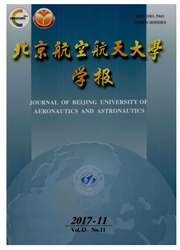

 中文摘要:
中文摘要:
为了有效实现跨音速气动伺服弹性的分析与综合,应用Volterra级数理论建立了一种跨音速非定常气动力状态空间建模方法.小扰动假设下的跨音速非定常气动力可以近似地表示为一阶Volterra级数的形式.通过CFD(Computation Fluid Dynamics)技术计算得到由结构变形产生的非定常气动力阶跃响应可辨识出Volterra核,由此得到频域的广义非定常气动力影响系数.利用气动力有理函数拟合,得到气动弹性状态空间模型.为验证气动力建模的有效性,以后掠机翼为例进行颤振计算.结果表明,Volterra级数方法得到的非定常气动力模型能够反映一定的跨音速气动特性,颤振计算与CFD-CSD(CFD-ComputationStructure Dynamics)的计算结果吻合很好.
 英文摘要:
英文摘要:
To implement aeroservoelastic analysis and synthesis in transonic flow, an approach for transonic unsteady aerodynamics modeling by applying Volterra series theory is presented. Based on the assumption of small perturbation, transonic unsteady aerodynamics can be expressed approximately as one-order Voherra series. Using the unsteady aerodynamics step responses due to the structural deformation calculated by CFD(computation fluid dynamics) technique, the Voherra kemels are determined, and the generalized unsteady AIC (aerodynamics influence coefficients) in frequency-domain are obtained. Then the aeroelastic state-space model is buih by rational function approximation. To validate the transonic aerodynamics modeling, flutter analysis of a swept wing is executed by the Voherra series approach and is compared with other methods. The results show the aerodynamics model educed by the Volterra series approach can reflect the features of transonic aerodynamics. The Volterra series approach coincides with the CFD-CSD(computation fluid dynamics-computation structure dynamics) method in flutter analysis.
 同期刊论文项目
同期刊论文项目
 同项目期刊论文
同项目期刊论文
 期刊信息
期刊信息
